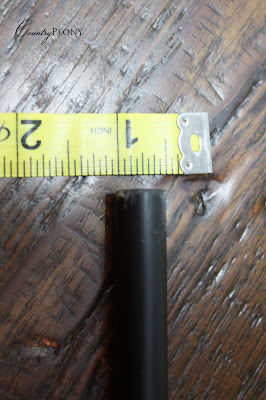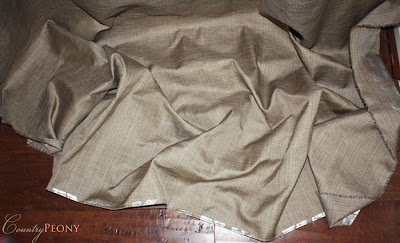Thank you for visiting. I now have a new home at www.countrypeony.com. I hope you will find me there.
The open concept floor plan of our house was a major reason my husband and I fell in love with it. However, some aspects of our house may be a little too open concept. My husband and I are in the process of updating a large space next to our great room into a theatre space. That said, we wanted to be able to close off the open doorway if necessary. We also didn't want to spend a lot of money on a permanent fix for the doorway. So we decided to add a curtain. This curtain was extremely simple to create. We are very happy with the result, and as soon as we are not happy with the result we can take it down.
 |
| The hallway before the curtain was added. |
For this simple DIY project, you will need: measuring tape, straight pins, fabric 1 1/2 times the width of the space you are covering to allow for scrunching (if you don't know how much fabric you need for your space, I would recommend bringing your measurements to the store with you and asking a sales associate what he/she recommends), sewing machine (or if you have the patience you can sew by hand), thread that matches your fabric, scissor, and a curtain rod with brackets and screws.
*As a warning, I am a visual person, and so I don't like to deal with exact numbers. So I do apologize in advance if this tutorial is more confusing than helpful. :)
I started the project off by measuring the thickness of the curtain rod. I took that measurement and then applied it to one end of my fabric. I marked off how much space I would need so the rod could fit into the fabric loop. Then I measured the same distance creating the same loop with stick pins down the same end of the fabric.
From here, I started to sew the edge of the loop that was attached by stick pins.
*When working with stick pins, always place the pin head toward you so that you don't stick yourself or ruin your machine when you are pulling the pins out.
*If you would like to create a nice hem, sew about a 1/2 inch seam to hide the rough edge of the fabric. Then proceed with sewing the loop for the rod to go through. I chose to keep the natural raw edge, because it matched the fabric that I was working with.
Next, I would recommend attaching the curtain rod to the wall. I mentioned above that I am more visual than number-based when it comes to projects. So, for the next step I inserted the curtain rod that was attached to the wall into the curtain loop. I then measured what length I wanted my curtain. I feel this is a good way to get the exact measurement and look that you are after. Maybe I am the only one, but I do not like curtains that are too short or too long. I prefer the curtains to hang a little and billow on the floor, but not to the point that they are a safety hazard.
So, while the extra curtain was laying on the floor, I determined where I wanted it to hang. I inserted my handy stick pins as a guide for where I wanted the curtain to end.
From here, I took the curtain off of the rod, and then sewed the curtain to the length that my stick pins were. I then restrung the rod through the curtain, and stepped back to take a look at the finished product.
 |
| Can you tell that I love this fabric, I also used it in my embroidery hoop art project. |
I also added the option of using a metal hook and decorative rope to open the area if we wanted the theatre room to be more accessible.
This project was much simpler than I anticipated, and I am excited to work on other curtain projects.
I feel curtains are also another way to add art to a space. Have you ever made your own curtains? If so, do you have any tips?










No comments:
Post a Comment